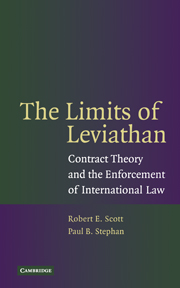Book contents
- Frontmatter
- Contents
- Foreword
- 1 Introduction
- 2 States, Firms, and the Enforcement of International Law
- 3 Lessons from Contract Theory
- 4 A Model of Optimal Enforcement
- 5 Patterns of International Law Enforcement
- 6 The Choice between Formal and Informal Enforcement
- 7 The Future of International Law and Its Enforcement
- Glossary
- Table of Authorities
- Index
5 - Patterns of International Law Enforcement
Published online by Cambridge University Press: 29 July 2009
- Frontmatter
- Contents
- Foreword
- 1 Introduction
- 2 States, Firms, and the Enforcement of International Law
- 3 Lessons from Contract Theory
- 4 A Model of Optimal Enforcement
- 5 Patterns of International Law Enforcement
- 6 The Choice between Formal and Informal Enforcement
- 7 The Future of International Law and Its Enforcement
- Glossary
- Table of Authorities
- Index
Summary
[A] judge deciding in reliance on an international norm will find a substantial element of discretionary judgment in the decision.
Sosa v. Alvarez-Machain, 542 U.S.692, 726 (2004) (Souter, J.)In Chapter 1, we introduced the distinction between formal and informal enforcement of international law. Here we expand on the concept. Formal enforcement, as we have used the term, requires that the law enforcer enjoy independence from national political authorities and has powers that lend salience to its decisions. As either independence or powers wane, the enforcement function depends less on the authority of the enforcer and more on the cooperation of others. As enforcement becomes dispersed, it becomes informal.
A few examples illustrate the distinction. A tribunal (whether domestic or international) whose members serve for substantial terms, the docket of which is not subject to the control of national political authorities, and which has the authority to impose fines or otherwise punish offenders has greater independence than one formed on an ad hoc basis to resolve a dispute at the request of the affected governments. The European Court of Justice (ECJ), the members of which serve for six years, which hears cases brought by individuals, national courts, and Community organs in addition to those brought by national governments, and which can impose money judgments with formal effect in national law, unambiguously carries out formal enforcement of Community law.
- Type
- Chapter
- Information
- The Limits of LeviathanContract Theory and the Enforcement of International Law, pp. 110 - 146Publisher: Cambridge University PressPrint publication year: 2006



